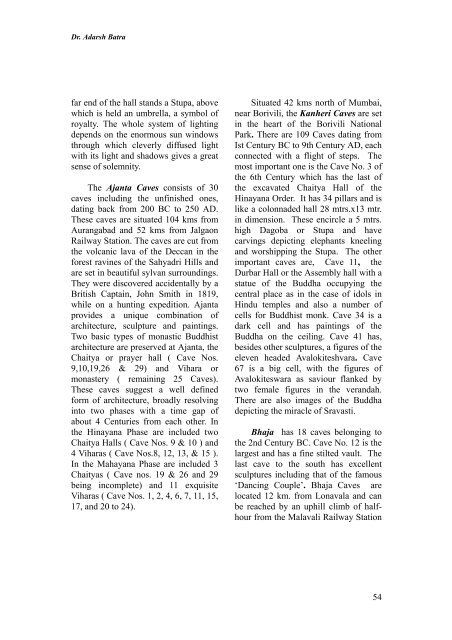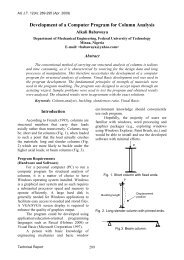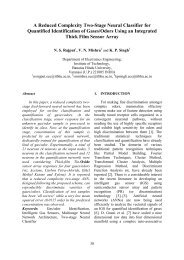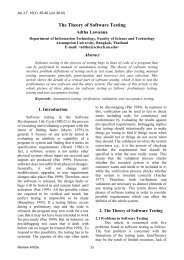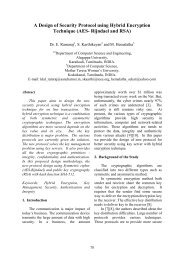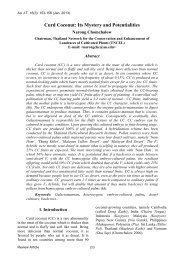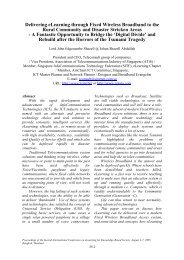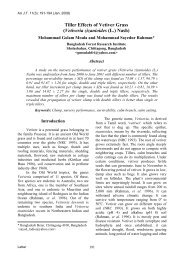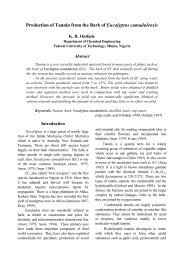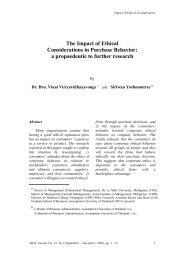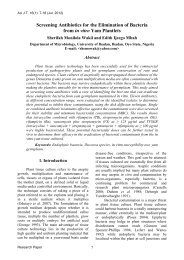Indian Tourist sites â In the footsteps of the Buddha - AU Journal ...
Indian Tourist sites â In the footsteps of the Buddha - AU Journal ...
Indian Tourist sites â In the footsteps of the Buddha - AU Journal ...
You also want an ePaper? Increase the reach of your titles
YUMPU automatically turns print PDFs into web optimized ePapers that Google loves.
Dr. Adarsh Batra<br />
far end <strong>of</strong> <strong>the</strong> hall stands a Stupa, above<br />
which is held an umbrella, a symbol <strong>of</strong><br />
royalty. The whole system <strong>of</strong> lighting<br />
depends on <strong>the</strong> enormous sun windows<br />
through which cleverly diffused light<br />
with its light and shadows gives a great<br />
sense <strong>of</strong> solemnity.<br />
The Ajanta Caves consists <strong>of</strong> 30<br />
caves including <strong>the</strong> unfinished ones,<br />
dating back from 200 BC to 250 AD.<br />
These caves are situated 104 kms from<br />
Aurangabad and 52 kms from Jalgaon<br />
Railway Station. The caves are cut from<br />
<strong>the</strong> volcanic lava <strong>of</strong> <strong>the</strong> Deccan in <strong>the</strong><br />
forest ravines <strong>of</strong> <strong>the</strong> Sahyadri Hills and<br />
are set in beautiful sylvan surroundings.<br />
They were discovered accidentally by a<br />
British Captain, John Smith in 1819,<br />
while on a hunting expedition. Ajanta<br />
provides a unique combination <strong>of</strong><br />
architecture, sculpture and paintings.<br />
Two basic types <strong>of</strong> monastic Buddhist<br />
architecture are preserved at Ajanta, <strong>the</strong><br />
Chaitya or prayer hall ( Cave Nos.<br />
9,10,19,26 & 29) and Vihara or<br />
monastery ( remaining 25 Caves).<br />
These caves suggest a well defined<br />
form <strong>of</strong> architecture, broadly resolving<br />
into two phases with a time gap <strong>of</strong><br />
about 4 Centuries from each o<strong>the</strong>r. <strong>In</strong><br />
<strong>the</strong> Hinayana Phase are included two<br />
Chaitya Halls ( Cave Nos. 9 & 10 ) and<br />
4 Viharas ( Cave Nos.8, 12, 13, & 15 ).<br />
<strong>In</strong> <strong>the</strong> Mahayana Phase are included 3<br />
Chaityas ( Cave nos. 19 & 26 and 29<br />
being incomplete) and 11 exquisite<br />
Viharas ( Cave Nos. 1, 2, 4, 6, 7, 11, 15,<br />
17, and 20 to 24).<br />
Situated 42 kms north <strong>of</strong> Mumbai,<br />
near Borivili, <strong>the</strong> Kanheri Caves are set<br />
in <strong>the</strong> heart <strong>of</strong> <strong>the</strong> Borivili National<br />
Park. There are 109 Caves dating from<br />
Ist Century BC to 9th Century AD, each<br />
connected with a flight <strong>of</strong> steps. The<br />
most important one is <strong>the</strong> Cave No. 3 <strong>of</strong><br />
<strong>the</strong> 6th Century which has <strong>the</strong> last <strong>of</strong><br />
<strong>the</strong> excavated Chaitya Hall <strong>of</strong> <strong>the</strong><br />
Hinayana Order. It has 34 pillars and is<br />
like a colonnaded hall 28 mtrs.x13 mtr.<br />
in dimension. These encircle a 5 mtrs.<br />
high Dagoba or Stupa and have<br />
carvings depicting elephants kneeling<br />
and worshipping <strong>the</strong> Stupa. The o<strong>the</strong>r<br />
important caves are, Cave 11, <strong>the</strong><br />
Durbar Hall or <strong>the</strong> Assembly hall with a<br />
statue <strong>of</strong> <strong>the</strong> <strong>Buddha</strong> occupying <strong>the</strong><br />
central place as in <strong>the</strong> case <strong>of</strong> idols in<br />
Hindu temples and also a number <strong>of</strong><br />
cells for Buddhist monk. Cave 34 is a<br />
dark cell and has paintings <strong>of</strong> <strong>the</strong><br />
<strong>Buddha</strong> on <strong>the</strong> ceiling. Cave 41 has,<br />
besides o<strong>the</strong>r sculptures, a figures <strong>of</strong> <strong>the</strong><br />
eleven headed Avalokiteshvara. Cave<br />
67 is a big cell, with <strong>the</strong> figures <strong>of</strong><br />
Avalokiteswara as saviour flanked by<br />
two female figures in <strong>the</strong> verandah.<br />
There are also images <strong>of</strong> <strong>the</strong> <strong>Buddha</strong><br />
depicting <strong>the</strong> miracle <strong>of</strong> Sravasti.<br />
Bhaja has 18 caves belonging to<br />
<strong>the</strong> 2nd Century BC. Cave No. 12 is <strong>the</strong><br />
largest and has a fine stilted vault. The<br />
last cave to <strong>the</strong> south has excellent<br />
sculptures including that <strong>of</strong> <strong>the</strong> famous<br />
‘Dancing Couple’. Bhaja Caves are<br />
located 12 km. from Lonavala and can<br />
be reached by an uphill climb <strong>of</strong> halfhour<br />
from <strong>the</strong> Malavali Railway Station<br />
54


